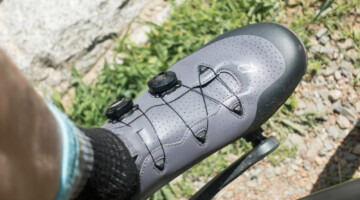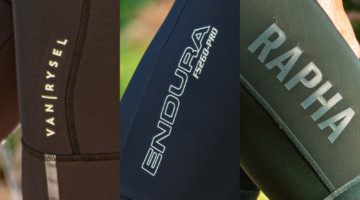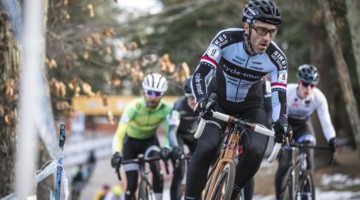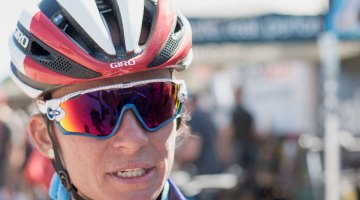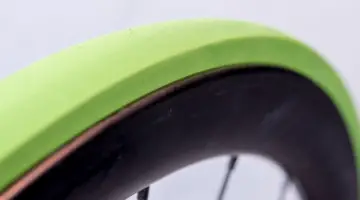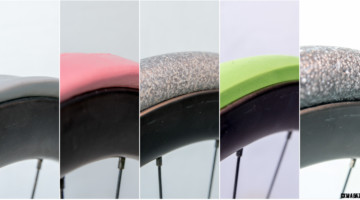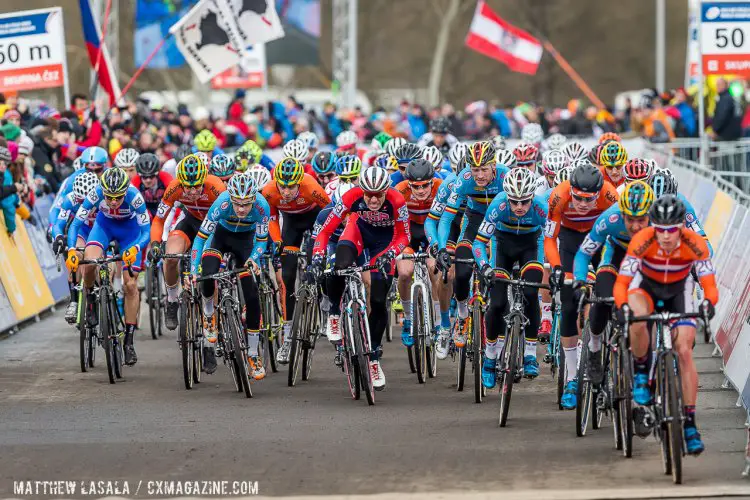
Van der Haar is an expert at taking the holeshot, and to be sure, starts matter in cycloross. © Matthew Lasala/Cyclocross Magazine
Cyclocross is nearly here, and the UCI races begin a month from now. Last week, Adam Myerson laid out the perfect training week for cyclocross. For today’s Technique Tuesday, he examines the importance of having a great start to the race. Both showing the methods for training and the technique involved in the sprint, Myerson offers plenty of advice for riders not to be left behind in the dust.
You can find other training ideas and articles at cycle-smart.com, as well as information on internationally-recognized coaching and clinic programs for all skill levels.
by Adam Myerson
Cyclocross is unique from most other cycling disciplines in that the field sprint comes at the start of the race rather than at the finish; you get your desert before dinner, as it were. Where you’re staged on the line, the time it takes you to get into the pedals, the gear you choose, and in what position you make it to the first corner, transition, or obstacle can impact your entire race. You may find yourself in the lead group with no extra effort, or you may spend the day stuck behind traffic or crashes, battling to get up to the group you belong based on fitness. A good start can also backfire and put you with riders you’re not strong enough to stay with, causing you to over race, blow up, and go back even further than you would have been had you been more conservative.
With all this to consider, one can see that starts are crucial in ‘cross. At the same time, it’s an aspect that riders rarely focus on or incorporate into their training, even though it’s easy to do so. There are two parts to consider: training and technique. I’ll outline how to improve both.
When you think about the effort you make for a start, you can boil the critical part down to the amount of time it takes you to go from a complete standstill, with one foot on the ground, up to your top speed; essentially, a 15-second sprint. There’s obviously a lot more that goes on, and you can view the entire first lap of a race as part of the start. What we want to focus on here is what you’re doing initially to get yourself into position for that first lap. That initial effort is a sprint, even if it’s followed by anaerobic work capacity, VO2 max, and eventually functional threshold power. The deterioration of intensity, starting from peak power and fading to threshold, is part of challenge of ‘cross, and doesn’t happen in the same way in any other event.
I’ve written elsewhere about how to structure a sprint workout on the road, and how to incorporate running workouts into your sprint training. In order to work on your ‘cross start, you can take the basic road-style sprint workout one step further by trying to reproduce the start of a race on your ‘cross bike. Find a safe spot with room to sprint uninterruprted, come to a complete stop with one foot on the ground, then begin a 15-second sprint from that position. When you sprint, attempt to clip in to the pedal quickly and shift down through the gears as you accelerate until you reach your top speed.
Of course, it’s not a simple as that. Here is where you can really work on all those little details that make the difference between which group you make on the first lap. Start with your strong side foot up every time (the foot you’d kick a soccer ball with), and at the 2 o’clock position. Make sure your other pedal is turned to a position that’s parallel to the crank, so that when you put your foot on it while it’s on the way up, you’ll clip right in when you begin to push down on the next pedal stroke. This is incredibly important, but something riders almost never do.
You’ve got two core choices between starting style. One approach is to sit on your saddle, with one foot on the ground, on your tiptoes, right next to the pedal and ready to step in quickly as you stand up to put weight on the other pedal. The second is to stand over your top tube, ready to push off with the foot that’s on the ground before you clip in. You can start on the hoods or the drops; whichever allows you to shift most quickly and is easier to reach while you’re waiting for the whistle. With modern shift/brake levers you’ll likely be on the hoods, but anatomy and fit will always be a factor.
Before you get into position for the start, you should have your starting gear already decided. If you use two chainrings, the big ring and one down from the easiest gear in back is a good guide, perhaps a 46 or 44 x 23 or 25. With a single ring, you’ll likely prefer to be 2 or 3 gears down, in a 23 or 21. Training is the time to experiment with all these variables so that you know what will work best for you in the race. How strong a sprinter you are, and how big a rider you are, will factor in as well. Don’t be afraid to start in your small ring if you use a double and that’s what works best for you, or if you’ve scoped out the start and think an uphill or heavy section means a smaller gear will be the ideal option.
In a racing situation, there’s even more you can do to ensure you get a good start. Always note who the official starter is, and watch that person closely as it gets nearer to the start. If there’s a countdown, anticipate the start. If it’s an unannounced start as is popular in New England and at many big races , never take your eyes off the official. You have to see them getting ready to blow the whistle before they blow it, and be in motion when it finally goes. If they walk behind the field, concentrate! Listen hard for the sound, and again, be ready to go with any early starters. You don’t want to be first to go early, but you do definitely want to be second.
It’s these little details that add up to make a big difference in your starts. Even a notoriously bad starter can find themselves with the leaders after the first turn or barrier if they include these techniques to their regular routine. When you pass one person in the first few pedal strokes, you’ve potentially passed a row of 8 people, and you won’t get that kind of return opportunity on your effort investment at any other time in the race. ‘Cross is a perfect balance of technique and fitness. Starts are a place you can work on both, together.























